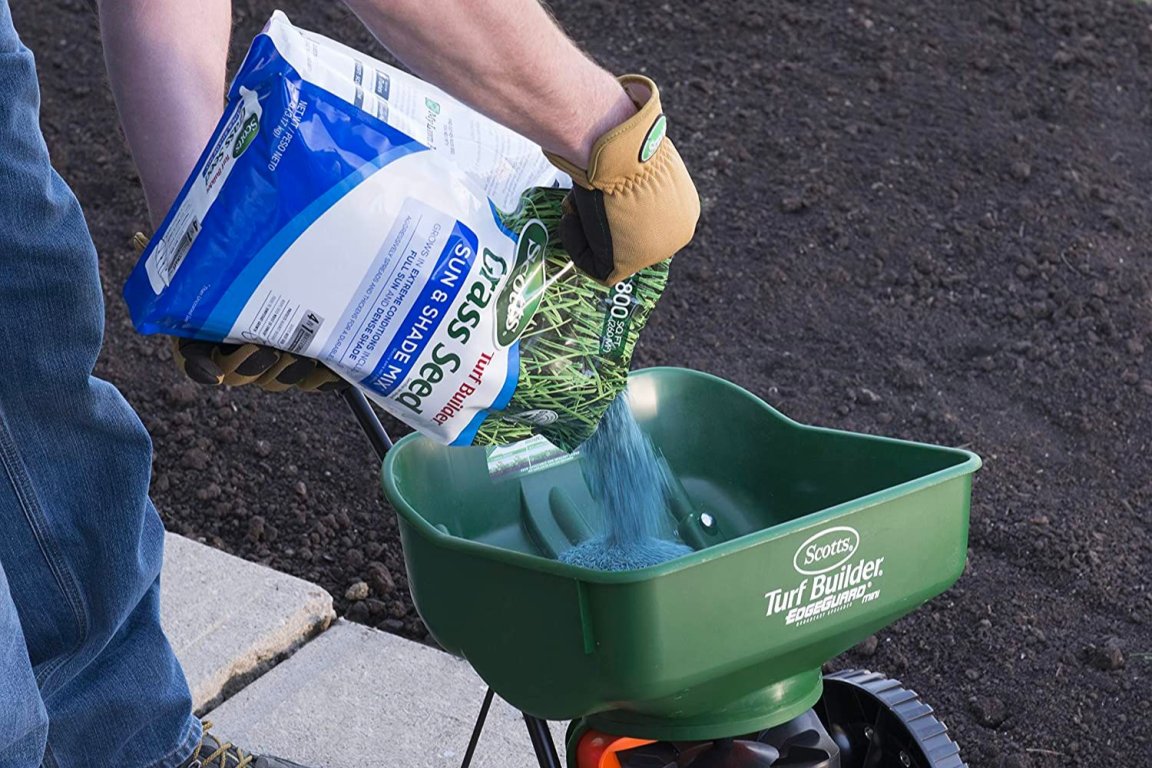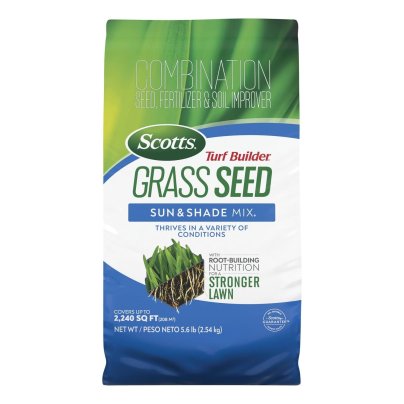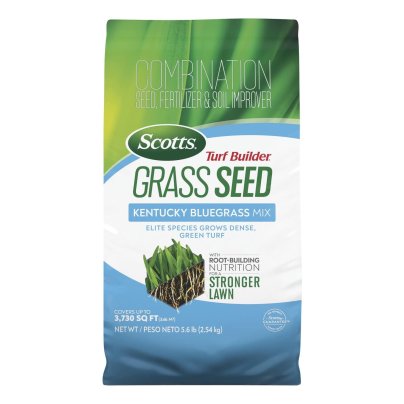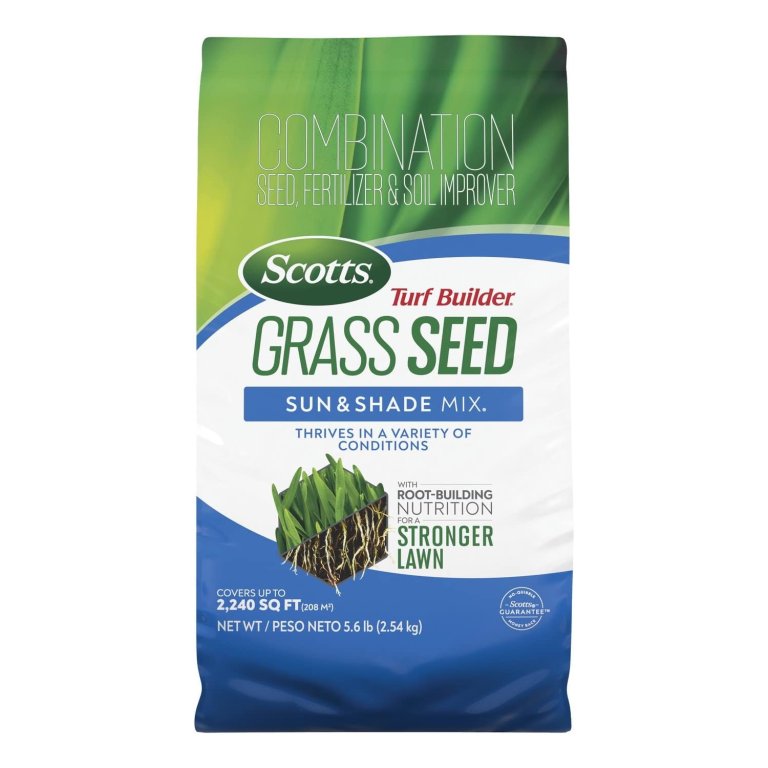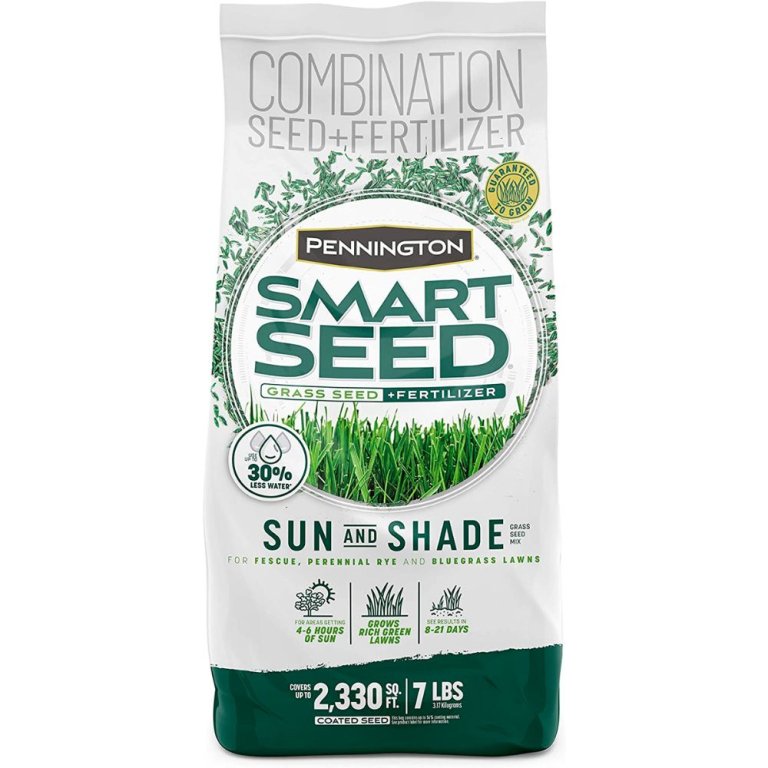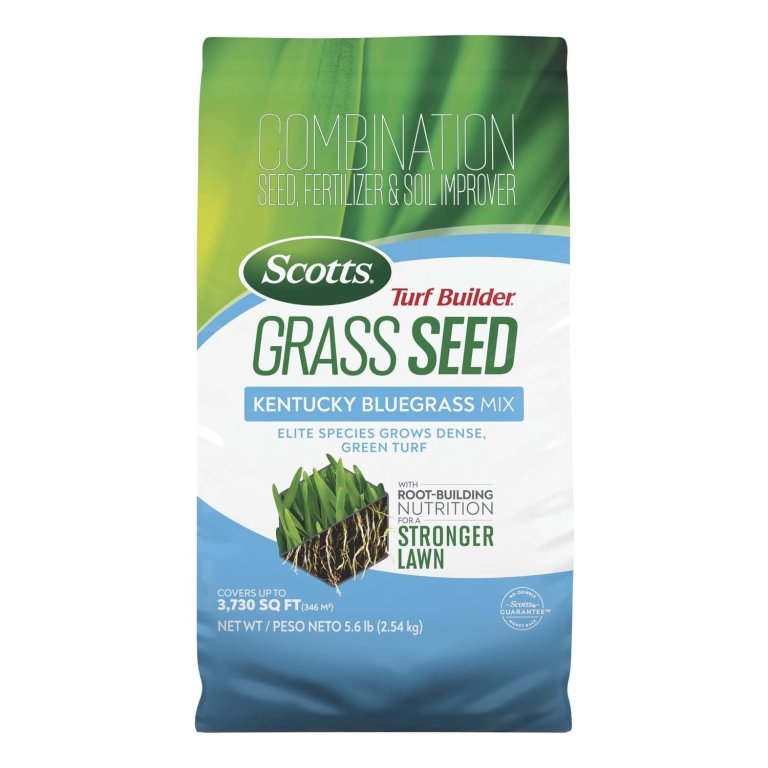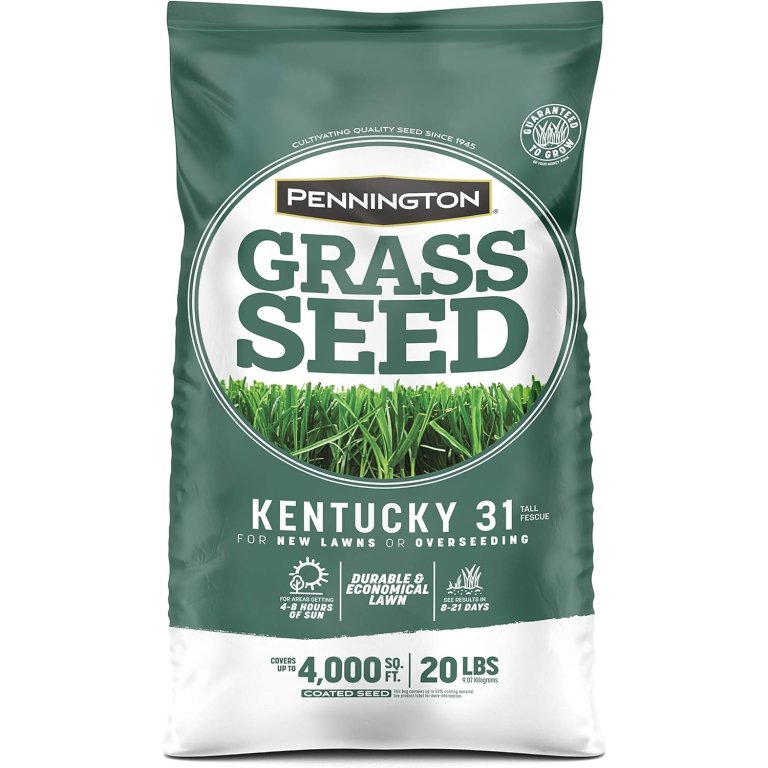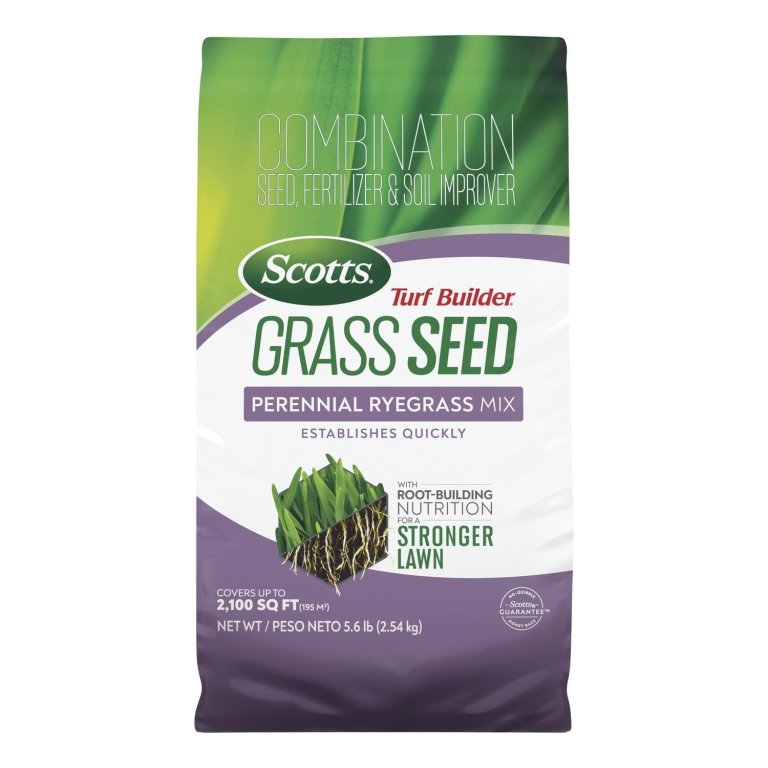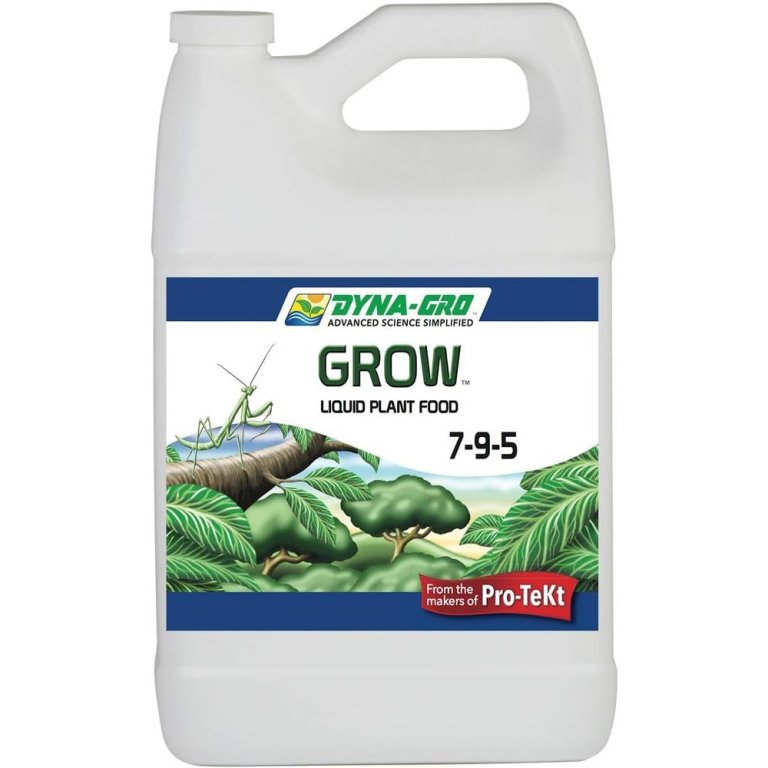We may earn revenue from the products available on this page and participate in affiliate programs. Learn More ›
If you live in the Northeast region of the United States, planting the right grass seed is the first step to a luscious lawn. Grasses will look their best when planted in a suitable climate zone, and they’ll be easier to maintain as well.
This guide breaks down the best grass species and explores the top picks for lawns in this part of the country. Keep reading to learn some key features to consider when shopping, and explore our picks for the best grass seed for Northeast areas. An in-depth review of the market and thorough product vetting went into assembling the list of top picks.
- BEST OVERALL: Scotts Turf Builder Grass Seed Sun & Shade Mix
- BEST BANG FOR THE BUCK: Pennington Smart Seed Sun and Shade Grass Seed Mix
- BEST KENTUCKY BLUEGRASS SEED: Scotts Turf Builder Kentucky Bluegrass Mix
- BEST FESCUE GRASS SEED: Pennington Kentucky 31 Tall Fescue Grass Seed
- BEST PERENNIAL RYEGRASS SEED: Scotts Turf Builder Perennial Ryegrass Mix
- ALSO CONSIDER: Dyna-Gro Grow 7-9-5 Liquid Plant Food

Product Comparison
| Coverage area | Grass types | Conditions | |
| Scotts Turf Builder Grass Seed Sun & Shade Mix | 7 pounds of seed for 2,800 square feet (for adding to existing lawn), 930 square feet (for new lawn coverage) | Fescue, perennial ryegrass, and Kentucky bluegrass mix | Sun and shade, medium to high drought resistance |
| Pennington Smart Seed Sun and Shade Grass Seed Mix | 7 pounds of seed will overseed 2,330 square feet or cover 777 square feet for new lawn coverage | Tall fescue, perennial ryegrass, Kentucky bluegrass, and fine fescue | Sun and shade, good drought resistance |
| Scotts Turf Builder Kentucky Bluegrass Mix | 5.6 pounds of seed covers 3,730 square feet for reseeding or 1,240 square feet for new lawn coverage | Kentucky bluegrass seed variation blend | Sun and shade, medium drought resistance |
| Pennington Kentucky 31 Tall Fescue Grass Seed | 20 pounds of seed will overseed 4,000 square feet of reseeding or 415 square feet for new lawn coverage | Tall fescue | Sun and shade, good drought resistance |
| Scotts Turf Builder Perennial Ryegrass Mix | 5.6-pound bag reseeds 2,100 square feet and 700 square feet for new lawn coverage | Perennial ryegrass varieties | Sun and light shade, low drought resistance |
| Dyna-Gro Grow 7-9-5 Liquid Plant Food | Unlisted | Most grass types | Most temperatures and humidity levels |
Our Top Picks
A good-looking lawn adds curb appeal to your home, and it’s no surprise that a healthy lawn starts at the root. Sowing the right seeds for your region will result in a prettier, more hardy, and easier-to-maintain lawn. The best grass seeds for the Northeast region are hardy cool-season grasses from reputable brands, perfect for growing in the Northeast climate.
Best Overall
Scotts Turf Builder Grass Seed Sun & Shade Mix
See ItWhat We Like
- WaterSmart Plus helps retain moisture, prevent disease
- Diverse mix: ryegrass, fescue, and bluegrass
- Thrives in sun, shade, drought, and cold
What We Don’t Like
- Not available in some states
- Some report slow germination or limited growth
Product Specs
- Coverage area: 7 pounds of seed for 2,800 square feet (for adding to existing lawn), 930 square feet (for new lawn coverage)
- Grass types: Fescue, perennial ryegrass, and Kentucky bluegrass mix
- Conditions: Sun and shade, medium to high drought resistance
If you’re looking for a grass seed that grows in less-than-perfect conditions, look no further than Scotts Turf Builder grass seed mix. This grass seed mixture blends a variety of fescues, perennial ryegrasses, and Kentucky bluegrasses to create a hardy and shade-resistant lawn. Ideal for Northern lawns, this seed mix is suitable for a variety of conditions, including full sun and densely shaded areas.
The seeds have Scotts’ exclusive 4-in-1 WaterSmart Plus coating, which helps absorb more water, feeds the seed with essential nutrients to jump-start growth, and protects fragile seedlings from disease. Once established, this seed mix creates a fine-bladed lawn with medium to high drought tolerance.
Get the Scotts Turf Builder Sun & Shade grass seed at Amazon (5.6-pound bag), Lowe’s, The Home Depot, or Target (2.4-pound bag).
Best Bang For The Buck
Pennington Smart Seed Sun and Shade Grass Seed Mix
See ItWhat We Like
- Mix includes ryegrass, fescue, and bluegrass
- Strong disease and drought resistance
- Uses 30% less water than standard seed
What We Don’t Like
- Needs 4–6 hours of sun daily
Product Specs
- Coverage area: 7 pounds of seed will overseed 2,330 square feet or cover 777 square feet for new lawn coverage
- Grass types: Tall fescue, perennial ryegrass, Kentucky bluegrass, and fine fescue
- Conditions: Sun and shade, good drought resistance
With a mix of different types of grass seeds and fertilizer, the Pennington Smart Seed grass seed mix sets you up for green grass and a healthy yard. This blend contains a mix of fine and tall fescues, perennial ryegrass, and Kentucky bluegrass seeds to help make a lush and tough lawn. This variety mix allows the grass to grow in both sunny and moderately shady conditions (ideal for areas with 4 to 6 hours of daily sun).
The seed is specially treated to improve its viability and is mixed with fertilizer to aid growth. Lawns grown with this seed may save 30 percent more water year after year when compared with other grass seeds.
Get the Pennington Smart Seed grass seed at Amazon, Lowe’s, Tractor Supply Co. (20-pound bag), or The Home Depot.
Best Bluegrass Seed
Scotts Turf Builder Kentucky Bluegrass Mix
See ItWhat We Like
- Cold-tolerant; works in 55–70°F range
- WaterSmart Plus coating aids moisture and protection
- Self-repairing; ideal for high-traffic lawns
What We Don’t Like
- Less drought-resistant than some competitors
- Not available in Louisiana
Product Specs
- Coverage area: 5.6 pounds of seed covers 3,730 square feet for reseeding or 1,240 square feet for new lawn coverage
- Grass types: Kentucky bluegrass seed variation blend
- Conditions: Sun and shade, medium drought resistance
In Northeastern states, Kentucky bluegrass is a popular choice for heavily used lawns. This Scotts Turf Builder has Kentucky bluegrass varieties to create a lawn that stands up to heavy traffic. This blend is also the brand’s most cold-tolerant grass seed mix, making it an excellent pick for frigid areas in the Northeast.
Beyond growing a lawn that looks dense and lush, this grass seed is also durable for high-traffic areas. It can self-repair through the seasons to withstand wear and tear, heat, and moderate drought conditions. Like other Scotts Turf products, it has Scotts’ exclusive WaterSmart Plus coating, which aids in water absorption, protects seedlings from disease, and provides the seed with essential nutrients for better growth.
Get the Scotts Turf Builder Kentucky bluegrass mix at Amazon, Lowe’s (7-pound bag), or The Home Depot (2.4-pound bag).
Best Fescue Grass Seed
Pennington Kentucky 31 Tall Fescue Grass Seed
See ItWhat We Like
- Tough, low-maintenance; handles heat, drought, traffic
- Reliable in sun or partial shade
- Available in multiple sizes for any lawn
What We Don’t Like
- Thick blades and light color may disappoint
Product Specs
- Coverage area: 20 pounds of seed will overseed 4,000 square feet of reseeding or 415 square feet for new lawn coverage
- Grass types: Tall fescue
- Conditions: Sun and shade, good drought resistance
Tall fescue grass is a favorite in the Northeast states for its strength and attractive look. The Pennington Kentucky 31 Tall Fescue grass seed is a classic choice for a durable and low-maintenance lawn. This grass seed grows thick blades of grass that stand up well to hot summers, heavy rain, and foot traffic.
The Kentucky 31 Tall Fescue variety in particular produces a lighter green turf that looks attractive for a front or back yard. This grass seed is a good choice for regions with hot summers; it has a superior heat tolerance compared to some other fescue grass varieties. It also grows best in full sun but can tolerate medium shade (in areas with 4 to 6 hours of sun per day).
Get the Pennington Kentucky 31 grass seed at Amazon, Lowe’s, The Home Depot (40-pound bag), or Target (3-pound bag).
Best Ryegrass Seed
Scotts Turf Builder Perennial Ryegrass Mix
See ItWhat We Like
- Stays lush with traffic and some shade
- WaterSmart Plus protects and boosts growth
- Fast germination; sprouts in about 8 days
What We Don’t Like
- Poor heat and drought tolerance
Product Specs
- Coverage area: 5.6-pound bag reseeds 2,100 square feet and 700 square feet for new lawn coverage
- Grass types: Perennial ryegrass varieties
- Conditions: Sun and light shade, low drought resistance
Perennial ryegrass is a popular grass type for several reasons: It germinates quickly and tolerates foot traffic while keeping a lush appearance. The Scotts Turf Builder ryegrass mix is an excellent pick for those looking for a perennial ryegrass mix.
This grass seed is designed for full sun and light shade. While it has a lower drought resistance and shade tolerance than some of Scotts’ other grass seed mixes, it does have the brand’s WaterSmart Plus Coating for better growth. The fine-bladed texture of this grass makes for a handsome lawn that establishes quickly, whether starting a new lawn, covering bare spots, or aiding in erosion control.
Get the Scotts Turf Builder ryegrass seed at Amazon, Lowe’s, or The Home Depot (7-pound bag).
Also Consider
Dyna-Gro Grow 7-9-5 Liquid Plant Food
See ItWhat We Like
- Concentrated formula; long-lasting with small doses
- Contains 16+ nutrients including N, P, K
- Works on many plants and grass types
What We Don’t Like
- Mixing and measuring can be tricky
Product Specs
- Coverage area: Unlisted
- Grass types: Most grass types
- Conditions: Most temperatures and humidity levels
Those who want to add a little oomph to their grass seed’s growth process can rely on Dyna-Gro’s liquid plant food. This extremely concentrated formula is made with a 7-9-5 NKP ratio; has a high concentration of nitrogen, potassium, and phosphorus; and includes other rich nutrients like calcium, magnesium, iron, boron, cobalt, molybdenum, zinc, chlorine, manganese, and sodium.
The dilution of this 32-ounce fertilizer depends on the plant, with most varieties requiring ½ or ¼ teaspoon per gallon of water. However, Dyna-Gro provides exact ratios for use on different plants and can be applied with a sprayer. Liquid lawn fertilizers are great for grass growth, but this Dyna-Gro plant food can also be used on plants both inside and out, hydroponics, and rocky soil varieties.
What our tester says: Mark Wolfe, a Bob Vila writer and product tester, notes in The Best Fertilizer for Indoor Plants: “The plants produced a healthy flush of new foliage with no symptoms of stress, disease, or insect infestation. We liked that this fertilizer contained a well-rounded balance of micronutrients in addition to the NPK content. We also noted that the manufacturer offers recommendations for different application rates to fit a variety of growing situations.” Get the Dyna-Gro plant food at Amazon or Greenhouse Megastore.
Jump to Our Top Picks
How We Chose the Best Grass Seed for the Northeast
Planting the right grass seed matters, especially in the Northeastern United States, where seasonal weather extremes and drought are a part of daily lawn care. Choosing the right grass variety can mean the difference between a lush, green lawn and a brown, patchy yard. When selecting our top picks for the best grass seed for the Northeast, we took grass variety into account, choosing grass varieties and grass seed mixes that grow fast and stand up well to the Northeastern climate.
Several popular grass types are suitable in the Northeast region, so we researched product specifications and consumer reviews to narrow down our top picks. We chose grass seeds from reputable companies who built a brand off of creating reliable grass and garden products, so you know your lawn will be off to a healthy start.
What to Consider When Choosing Grass Seed for the Northeast

Selecting a suitable grass seed can mean the difference between a green, hardy, beautiful lawn and a patchy and finicky one. When buying grass seed for Northeast area lawns, consider the climate, grass type, and germination rate, as well as the sun exposure and traffic level of your lawn area.
Soil Climate and Climate of Northeastern U.S.
Each region of the United States has different climate and soil conditions, both of which are major influences on application and lawn growth. When it comes to grass adaptation, the United States is divided into four climate zones.
The Northeast has distinct seasons; cold winters tend to bring rain and snow, while summers can be humid, ranging from warm in the northern areas to hot farther south. Due to these weather conditions, Northeast lawns exist in a cool, humid zone. The best grass types for the Northeast region can tolerate and thrive in these weather patterns.
In the Northeast region, plentiful rainfall causes soil to leach some of its basic elements, like alkali nutrients, resulting in more acidic soil left behind. To maintain a proper soil pH (usually between 6 and 6.5 for grass), many gardeners in the Northeastern United States apply lime every few years, so that’s a factor to keep in mind along with your regular lawn maintenance routine.
Types of Cool Season Grasses
In the United States, grass types are broadly classified as warm-season or cool-season grasses. Each grass type is better suited for different geographic regions and their climates. Warm-season grasses are best suited to warm climates, like in the Southern United States.
Cool-season grasses grow in and withstand cold winters and hot summers, like in the Northeastern United States. These grasses are hardy and more likely to stay green throughout the year (except when the mercury dips below zero degrees).
Kentucky bluegrass, ryegrass, and tall and fine fescues are some of the best cool-season grass options for cool, humid zones like the Northeast.
Sun Exposure
Grasses vary in the amount of sun they need to look their best. Some grasses need full, direct sun while others can tolerate shade. If you have a shady yard, shade-tolerant grasses include perennial ryegrass and some varieties of fescue.
Sowing a single cool-season grass type is adequate for some lawns, but for an even hardier lawn, plant a combination of cool-season grasses together. Mixing different species, especially blending types that have different sun requirements, can result in a lusher-looking lawn overall. It allows for each grass type to grow, despite different sun and shade conditions. Some brands sell grass seeds intended for areas that get varying amounts of sun and shade.
Traffic Level
Every household treats its lawn differently; one family may see the front yard as a decorative part of the home, while another uses it as a place for rough-and-tumble play. High foot traffic compacts soil, crushing air pockets that hold vital oxygen, nutrients, and water which are necessary for a healthy lawn. If your lawn sees a lot of activity, choose a grass type that can withstand trampling.
Grasses like Kentucky bluegrass, perennial ryegrass, and tall fescue are some cool-season grasses that hold up well to high traffic, while fine fescue is less durable (but can still tolerate some foot traffic).
Versatility and Adaptability
When it comes to growing a lush lawn, most gardeners choose a seed blend. Unlike single-variety lawn seeds, blends have multiple grass varieties that are intentionally paired up to create a better-looking and hardier lawn.
These blends combine the benefits of various seeds to achieve a tougher and more uniform lawn. Different blends can better tailor the lawn to an area’s climate, lighting exposure, or traffic level, making them a more versatile and adaptable choice for most homes. As a bonus, lawns grown from grass seed blends are also more tolerant of diseases.
Germination Percentage
Even if you lovingly tend to your newly planted grass, not every seed will grow. Germination percentage is a measure of how many seeds from a batch germinate, displayed in a percentage. Factors like air and soil temperature, moisture levels, soil quality, and seed age and quality can all affect the germination percentage.
Some grass seed labels will display a germination percentage, sometimes broken down by seed type. Generally, the higher the quality of the seed, the higher the germination rate—and also the higher the price. In the long run, it pays to buy a high-quality seed with a high germination rate. These seeds can have a germination rate of 90 to 95 percent, which means fewer wasted seeds and a lusher lawn.
FAQs
With the right grass seed and proper maintenance, you can have a gorgeous, green lawn that is the talk of the block. Still having trouble choosing the best grass seed for your lawn? Ahead are some frequently asked questions about choosing and planting grass seed in the Northeast.
In the Northeast, it’s best to plant grass seeds in the late summer or early fall.
For most lawns in the region, the best grass seed for New England is a robust, cool-season blend.
To prepare your lawn for seeding, remove any debris like sticks, large rocks, and weeds. Break up the soil with a spade, garden fork, hoe, or aerator, removing any other debris as you go. If the grass seed does not contain fertilizer, consider adding fertilizer before seeding the lawn. Seed the lawn according to the manufacturer’s directions.
Northeast Pennsylvania is in the cool, humid zone, so cool-season grasses that thrive in the Northeastern United States (like fescues, perennial ryegrass, and Kentucky bluegrass) are suitable.
Cool-season grasses thrive best in New York’s wide range of temperatures. Look for a blend of Kentucky bluegrass and fescue, which is a mix that can tolerate the extremes of cold and heat.
